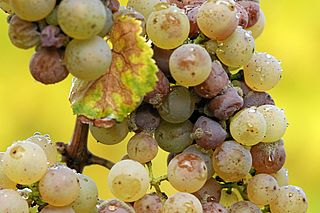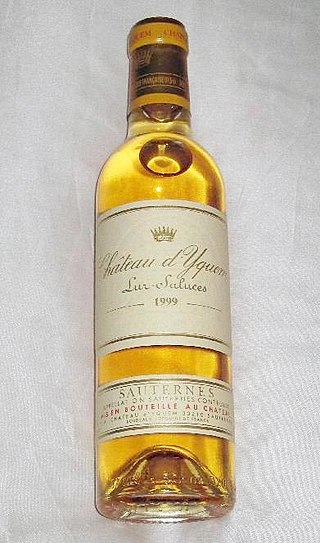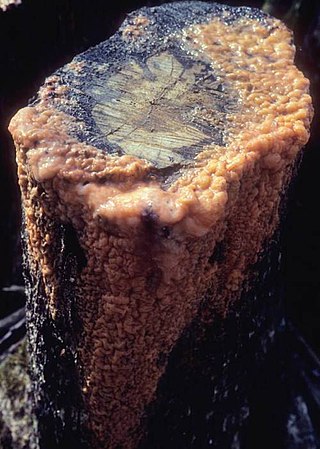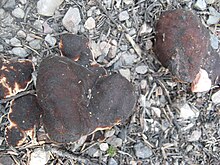
Lyle is a city in Mower County, Minnesota, United States. The city lies on the north side of the Iowa border. The population was 522 at the 2020 census.

Noble rot is the beneficial form of a grey fungus, Botrytis cinerea, affecting wine grapes. Infestation by Botrytis requires moist conditions, but if the weather stays wet, the damaging form, "grey rot", can destroy crops of grapes. Grapes typically become infected with Botrytis when they are ripe. If they are then exposed to drier conditions and become partially raisined, this form of infection is known as noble rot. Grapes picked at a certain point during infestation can produce particularly fine and concentrated sweet wine. Wines produced by this method are known as botrytized wines.

Botrytis cinerea is a necrotrophic fungus that affects many plant species, although its most notable hosts may be wine grapes. In viticulture, it is commonly known as "botrytis bunch rot"; in horticulture, it is usually called "grey mould" or "gray mold".

Late harvest wine is wine made from grapes left on the vine longer than usual. Late harvest is usually an indication of a sweet dessert wine, such as late harvest Riesling. Late harvest grapes are often more similar to raisins, but have been naturally dehydrated while on the vine.

Sauternes is a French sweet wine from the region of the same name in the Graves section in Bordeaux. Sauternes wine is made from Sémillon, sauvignon blanc, and muscadelle grapes that have been affected by Botrytis cinerea, also known as noble rot. This causes the grapes to become partially raisined, resulting in concentrated and distinctively flavored wines. Due to its climate, Sauternes is one of the few wine regions where infection with noble rot is a frequent occurrence. Even so, production is a hit-or-miss proposition, with widely varying harvests from vintage to vintage. Wines from Sauternes, especially the Premier Cru Supérieur estate Château d'Yquem, can be very expensive, largely due to the very high cost of production. Barsac lies within Sauternes and is entitled to use either name. Somewhat similar but less expensive and typically less-distinguished wines are produced in the neighboring regions of Monbazillac, Cérons, Loupiac and Cadillac. In the United States, there is a semi-generic label for sweet white dessert wines known as sauterne without the "s" at the end and uncapitalized.

De Bortoli Wines is a wine-producing private company based in Australia. Its range of wines includes the sweet white Noble One.

Botryotinia is a genus of ascomycete fungi causing several plant diseases. The anamorphs of Botryotinia are mostly included in the "imperfect fungi" genus Botrytis. The genus contains 22 species and one hybrid.

The genus Ramaria comprises approximately 200 species of coral fungi. Several, such as Ramaria flava, are edible and picked in Europe, though they are easily confused with several mildly poisonous species capable of causing nausea, vomiting, and diarrhea; these include R. formosa and R. pallida. Three Ramaria species have been demonstrated to contain a very unusual organoarsenic compound homoarsenocholine.

Bovista aestivalis is a species of small puffball in the family Agaricaceae. It is generally found in the coastal regions of California, but was reported from Korea in 2015. This fungus is often confused with Bovista dermoxantha, because of its similar peridium, and Bovista plumbea. The surest way to tell the species apart is to examine the spores and exoperidium, respectively, with a microscope.

Ramaria botrytis, commonly known as the clustered coral, the pink-tipped coral mushroom, or the cauliflower coral, is an edible species of coral fungus in the family Gomphaceae. Its robust fruit body can grow up to 15 cm (6 in) in diameter and 20 cm (8 in) tall, and resembles some marine coral. Its dense branches, which originate from a stout, massive base, are swollen at the tips and divided into several small branchlets. The branches are initially whitish but age to buff or tan, with tips that are pink to reddish. The flesh is thick and white. The spores, yellowish in deposit, are ellipsoid, feature longitudinal striations, and measure about 13.8 by 4.7 micrometers.
Gammaflexiviridae is a family of viruses in the order Tymovirales. Fungi serve as natural hosts. There is only one genus in the family, Mycoflexivirus, which has one species: Botrytis virus F.

Otidea is a genus of fungi in the family Pyronemataceae. The genus is widely distributed in northern temperate regions.
Urceolaria is a genus of fungi in the Pezizales order. The relationship of this taxon to other taxa within the order is unknown, and it has not yet been placed with certainty into any family. The genus was described by the German mycologist Hermann Friedrich Bonorden in 1851. According to the Dictionary of the Fungi, the genus contains about 100 species.

Botrytis allii is a plant pathogen, a fungus that causes neck rot in stored onions and related crops. Its teleomorph is unknown, but other species of Botrytis are anamorphs of Botryotinia species. The species was first described scientifically by Mancel Thornton Munn in 1917.

Fusicolla is a genus of seven species of ascomycete fungi in the family Nectriaceae. The genus was circumscribed by German mycologist Hermann Friedrich Bonorden in 1851. Fungi in the genus produce slimy orange sheets over the substrate, within which the perithecia can be either fully or partially immersed. Asexual spores are similar to those of Fusarium.
Hermann Friedrich Bonorden was a German physician and mycologist. During his career he served as a Regimentarzt in Köln.

Botrytis is a genus of anamorphic fungi in the family Sclerotiniaceae. Botrytis belongs to the group hyphomycetes and has about 30 different species. It is a plant parasite as well as saprophytes on both agricultural and forest trees. It produces stout, dark, branching conidiophores that bear clusters of paler conidia on denticles from apical ampullae. It is a common outdoor fungus and can be detected in spore trap samples. The fungus is often found growing on indoor plants. Although no mycotoxin has been reported from this fungus, it may cause hay fever, asthma and keratomycosis. The most common species is B. cinerea, which is a plant pathogen causing gray mould on a very broad range of hosts including some common ornamental plants, such as geranium, begonia, rose, lily, dogwood, rhododendron, dahlia, magnolia, camellia and fruits and produce. This fungus is mainly of outdoor origin, although it may be from growth on fruits or flowers brought in from outdoors. Some houseplants can be infected by this fungus, such as cyclamen, poinsettia, chrysanthemum, and gerbera. Other species of Botrytis may be present, such as B. peoniae on peonies, B. squamosa on onion, and B. tulipae on tulips. These species of Botrytis share some common characteristics in pathology and ecology.
Ulocladium botrytis is an anamorphic filamentous fungus belonging to the phylum Ascomycota. Commonly found in soil and damp indoor environments, U.botrytis is a hyphomycetous mould found in many regions of the world. It is also occasionally misidentified as a species of the genera Alternaria or Pithomyces due to morphological similarities. Ulocladium botrytis is rarely pathogenic to humans but is associated with human allergic responses and is used in allergy tests. Ulocladium botrytis has been implicated in some cases of human fungal nail infection. The fungus was first discovered in 1851 by German mycologist Carl Gottlieb Traugott Preuss.

Pyraclostrobin is a quinone outside inhibitor (QoI)-type fungicide used in agriculture. Among the QoIs, it lies within the strobilurin chemical class.

Tulasnella aurantiaca is a species of fungus in the order Cantharellales. It produces orange-red, pustular, gelatinous anamorphic states on dead, deciduous wood. Originally described from Europe, it also occurs in North America where the species appears to be more common.















